IBM EGX-400, EGX-600 User Manual
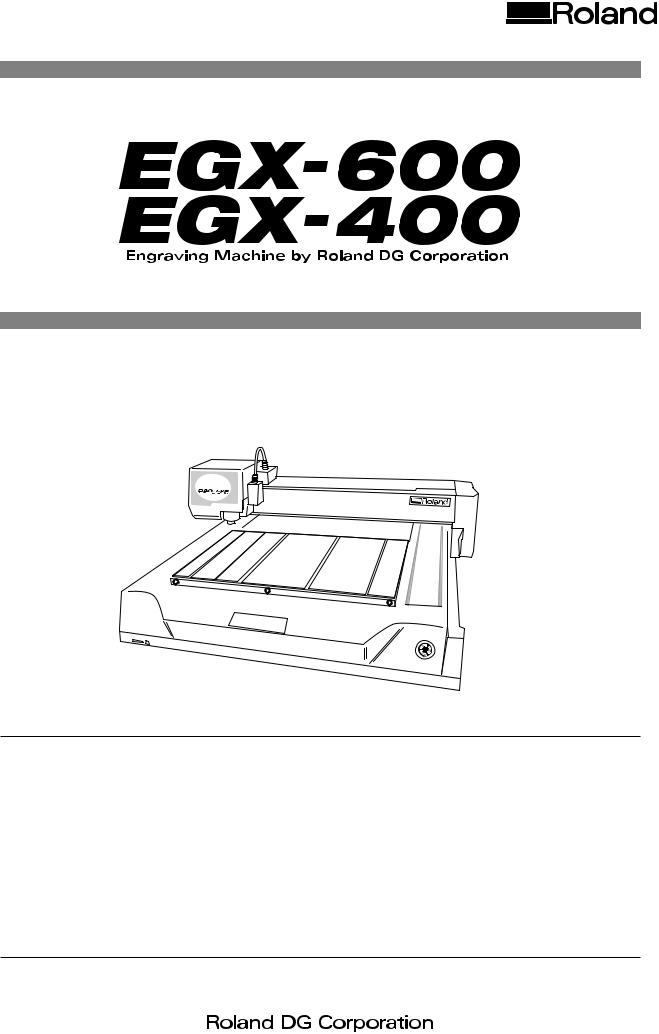
User’s Manual
Thank you very much for purchasing the product.
•To ensure correct and safe usage with a full understanding of this product's performance, please be sure to read through this manual completely and store it in a safe location.
•Unauthorized copying or transferral, in whole or in part, of this manual is prohibited.
•The contents of this operation manual and the specifications of this product are subject to change without notice.
•The operation manual and the product have been prepared and tested as much as possible. If you find any misprint or error, please inform us.
•Roland DG Corp. assumes no responsibility for any direct or indirect loss or damage which may occur through use of this product, regardless of any failure to perform on the part of this product.
•Roland DG Corp. assumes no responsibility for any direct or indirect loss or damage which may occur with respect to any article made using this product.
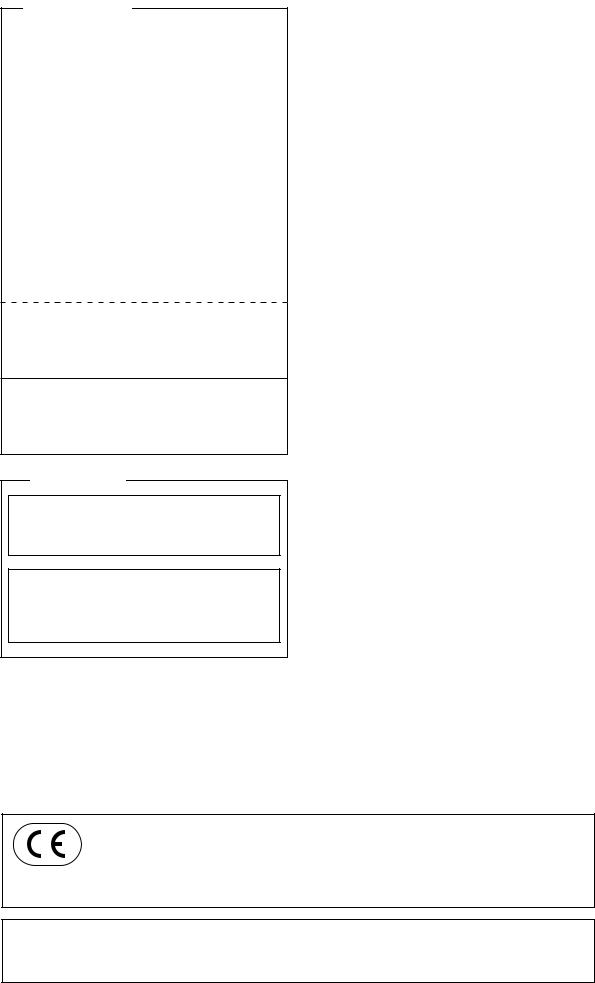
For the USA
FEDERAL COMMUNICATIONS COMMISSION
RADIO FREQUENCY INTERFERENCE
STATEMENT
This equipment has been tested and found to comply with the limits for a Class A digital device, pursuant to Part 15 of the FCC Rules.
These limits are designed to provide reasonable protection against harmful interference when the equipment is operated in a commercial environment.
This equipment generates, uses, and can radiate radio frequency energy and, if not installed and used in accordance with the instruction manual, may cause harmful interference to radio communications.
Operation of this equipment in a residential area is likely to cause harmful interference in which case the user will be required to correct the interference at his own expense.
Unauthorized changes or modification to this system can void the users authority to operate this equipment.
The I/O cables between this equipment and the computing device must be shielded.
For Canada
CLASS A |
NOTICE |
This Class A digital apparatus meets all requirements of the
Canadian Interference-Causing Equipment Regulations.
CLASSE A |
AVIS |
Cet appareil numérique de la classe A respecte toutes les exigences du Règlement sur le matériel brouilleur du Canada.
ROLAND DG CORPORATION
1-6-4 Shinmiyakoda, Hamamatsu-shi, Shizuoka-ken, JAPAN 431-2103 MODEL NAME : See the MODEL given on the rating plate.
RELEVANT DIRECTIVE : EC MACHINERY DIRECTIVE (98/37/EC)
EC LOW VOLTAGE DIRECTIVE (73/23/EEC)
EC ELECTROMAGNETIC COMPATIBILITY DIRECTIVE (89/336/EEC)
WARNING
This is a Class A product. In a domestic environment this product may cause radio interference in which case the user may be required to take adequate measures.

GENERAL SAFETY RULES
WARNING ! Read and understand all instructions. Failure to follow all instructions listed below, may result in electric shock, fire and/or serious personal injury.
SAVE THESE INSTRUCTIONS.
Work Area
Keep your work area clean and well lit. Cluttered benches and dark areas invite accidents.
Do not operate power tools in explosive atmospheres, such as in the presence of flammable liquids, gases, or dust.
Power tools create sparks which may ignite the dust or fumes.
Keep bystanders, children, and visitors away while operating a power tool. Distractions can cause you to lose control.
Tool Use and Care
Use clamps or other practical way to secure and support the workpiece to a stable platform. Holding the work by hand or against your body is unstable and may lead to loss of control.
Do not force tool. Use the correct tool for your application.
The correct tool will do the job better and safer at the rate for which it is designed.
Do not use tool if switch does not turn it on or off. Any tool that cannot be controlled with the switch is dangerous and must be repaired.
Electrical Safety
Grounded tools must be plugged into an outlet properly installed and grounded in accordance with all codes and ordinances. Never remove the grounding prong or modify the plug in any way. Do not use any adaptor plugs. Check with a qualified electrician if you are in doubt as to whether the outlet is properly grounded. If the tools should electrically malfunction or break down, grounding provides a low resistance path to carry electricity away from the user.
Avoid body contact with grounded surfaces such as pipes, radiators, ranges and refrigerators. There is an increased risk of electric shock if your body is grounded.
Don't expose power tools to rain or wet conditions.Water entering a power tool will increase the risk of electric shock.
Do not abuse the cord. Never use the cord to carry the tools or pull the plug from an outlet. Keep cord away from heat, oil, sharp edges or moving parts. Replace damaged cords immediately. Damaged cords increase the risk of electric shock.
When operating a power tool outside, use an outdoor extension cord marked "W-A" or "W." These cords are rated for outdoor use and reduce the risk of electric shock.
Personal Safety
Stay alert, watch what you are doing and use common sense when operating a power tool. Do not use tool while tired or under the influence or drugs, alcohol, or medication. A moment of inattention while operating power tools may result in serious personal injury.
Dress properly. Do not wear loose clothing or jewelry. Contain long hair. Keep your hair, clothing, and gloves away from moving parts. Loose clothes, jewelry, or long hair can be caught in moving parts.
Avoid accidental starting. Be sure switch is off before plugging in. Carrying tools with your finger on the switch or plugging in tools that have the switch on invites accidents.
Remove adjusting keys or switches before turning the tool on. A wrench or a key that is left attached to a rotating part of the tool may result in personal injury.
Do not overreach. Keep proper footing and balance at all times. Proper footing and balance enables better control of the tool in unexpected situations.
Use safety equipment. Always wear eye protection. Dust mask, non-skid safety shoes, hard hat, or hearing protection must be used for appropriate conditions.
Disconnect the plug from the power source before making any adjustments, changing accessories, or storing the tool.
Such preventive safety measures reduce the risk of starting the tool accidentally.
Store idle tools out of reach of children and other untrained persons. Tools are dangerous in the hands of untrained users.
Maintain tools with care. Keep cutting tools sharp and clean.
Properly maintained tools, with sharp cutting edges are less likely to bind and are easier to control.
Check for misalignment or binding of moving parts, breakage of parts, and any other condition that may affect the tools operation. If damaged, have the tool serviced before using. Many accidents are caused by poorly maintained tools.
Use only accessories that are recommended by the manufacturer for your model. Accessories that may be suitable for one tool, may become hazardous when used on another tool.
SERVICE
Tool service must be performed only by qualified repair personnel. Service or maintenance performed by unqualified personnel could result in a risk of injury.
When servicing a tool, use only identical replacement parts. Follow instructions in the Maintenance section of this manual. Use of unauthorized parts or failure to follow Maintenance Instructions may create a risk or electric shock or injury.

RÉ GLES DE SÉ CURITÉ GÉ NÉ RALES
AVERTISSEMENT ! Vous devez lire et comprendre toutes les instructions. Le non-respect, même partiel, des instructions ci-après entraîne un risque de choc électrique, d'incendie et/ou de blessures graves.
CONSERVEZ CES INSTRUCTIONS
Aire de travail
Veillez à ce que l'aire de travail soit propre et biené clairé e.
Le désordre et le manque de lumière favorisent les accidents.
N'utilisez pas d'outilsélectriques dans une atmosphè re explosive, par exemple en pré sence de liquides, de gaz ou de poussiè res inflammables. Les outils électriques créent des
étincelles qui pourraient enflammer les poussières ou les vapeurs.
Tenez à distance les curieux, les enfants et les visiteurs pendant que vous travaillez avec un outil é lectrique. Ils pourraient vous distraire et vous faire une fausse manoeuvre.
Sé curité é lectrique
Les outils mis à la terre doivent ê tre branché s dans une prise de courant correctement installé e et mise à la terre conformé ment à tous les codes et ré glements pertinents. Ne modifiez jamais la fiche de quelque faç on que ce soit, par exemple en enlevant la broche de mise à la terre. N'utilisez pas d'adaptateur de fiche. Si vous ên'tes pas certain que la prise de courant est correctement mise à la terre, adressez-vous à un é lectricien qualifié . En cas de défaillance ou de défectuosité électrique de l'outil, une mise à la terre offre un trajet de faible résistance à l'électricité qui autrement risquerait de traverser l'utilisateur.
É vitez tout contact corporel avec des surfaces mises à la terre (tuyauterie, radiateurs, cuisiniè res, ré frigé rateurs, etc.).
Le risque de choc électrique est plus grand si votre corps est en contact avec la terre.
N'exposez pas les outilsé lectriques à la pluie ou à l'eau.La présence d'eau dans un outil électrique augmente le risque de choc électrique.
Ne maltraitez pas le cordon. Ne transportez pas l'outil par son cordon et ne dé branchez pas la fiche en tirant sur le cordon. N'exposez pas le cordonà la chaleur, à des huiles, à des arê tes vives ou à des piè ces en mouvement. Remplacez immé diatement un cordon endommagé . Un cordon endommagé augmente le risque de choc électrique.
Lorsque vous utilisez un outil é lectrique à l'exté rieur, employez un prolongateur pour l'exté rieur marqué "W-A" ou "W". Ces cordons sont faits pour êntre utilisés à l'extérieur et réduisent le risque de choc électrique.
Sé curité des personnes
Restez alerte, concentrez-vous sur votre travail et faites preuve de jugement. N'utilisez pas un outilé lectrique si vous
ê tes fatigué ou sous l'influence de drogues, d'alcool ou de mé dicaments. Un instant d'inattention suffit pour entraîner des blessures graves.
Habillez-vous convenablement. Ne portez ni vê tements flottants ni bijoux. Confinez les cheveux longs. N'approchez jamais les cheveux, les vê tements ou les gants des piè ces en mouvement. Des vêtements flottants, des bijoux ou des cheveux longs risquent d'être happés par des pièces en mouvement.
Mé fiez-vous d'un dé marrage accidentel. Avant de brancher l'outil, assurez-vous que son interrupteur est sur ARRÈ T.
Le fait de transporter un outil avec le doigt sur la détente ou de brancher un outil dont l'interrupteur est en position MARCHE peut mener tout droit à un accident.
Enlevez les clé s de ré glage ou de serrage avant de dé marrer l'outil.Une clé laissée dans une pièce tournante de l'outil peut provoquer des blessures.
Ne vous penchez pas trop en avant. Maintenez un bon appui et restez en é quilibre en tout temps. Un bonne stabilité vous permet de mieux réagir à une situation inattendue.
Utilisez des accessoires de sé curité . Portez toujours des lunettes ou une visiè re. Selon les conditions, portez aussi un masque antipoussière, des bottes de sécurité antidérapantes, un casque protecteur et/ou un appareil antibruit.
Utilisation et entretien des outils
Immobilisez le maté riau sur une surface stable au moyen de brides ou de toute autre faç on adé quate. Le lait de tenir la pièce avec la main ou contre votre corps offre une stabilité insuffisante et peut amener un dérapage de l'outil.
Ne forcez pas l'outil. Utilisez l'outil approprié à la tâ che.
L'outil correct fonctionne mieux et de façon plus sécuritaire.
Respectez aussi la vitesse de travail qui lui est propre.
N'utilisez pas un outil si son interrupteur est bloqué . Un outil que vous ne pouvez pas commander par son interrupteur est dangereux et doit être réparé.
Dé branchez la fiche de l'outil avant d'effectuer uné glage,r de changer d'accessoire ou de ranger l'outilDe. telles mesures préventives de sécurité réduisent le risque de démarrage accidentel de l'outil.
Rangez les outils hors de la porté e des enfants et d'autres personnes inexpé rimenté es. Les outils sont dangereux dans les mains d'utilisateurs novices.
Prenez soin de bien entretenir les outils. Les outils de coupe doivent ê tre toujours bien affû té s et propres. Des outils bien entretenus, dont les arêtes sont bien tranchantes, sont moins susceptibles de coincer et plus faciles à diriger.
Soyez attentif à tout dé salignement ou coincement des piè ces en mouvement, à tout bris ou à toute autre condition pré judiciable au bon fonctionnement de l'outil. Si vous constatez qu'un outil est endommagé , faites-le ré parer avant de vous en servir. De nombreux accidents sont causés par des outils en mauvais état.
N'utilisez que des accessoires que le fabricant recommande pour votre modè le d'outil.Certains accessoires peuvent convenir à un outil, mais être dangereux avec un autre.
RÉ PARATION
La ré paration des outils é lectriques doit ê tre confié e à un ré parateur qualifié . L'entretien ou la réparation d'un outil
électrique par un amateur peut avoir des conséquences graves.
Pour la ré paration d'un outil, n'employez que des èpices de rechange d'origine. Suivez les directives donné es à la section "Ré paration" de ce manuel. L'emploi de pièces non autorisées ou le non-respect des instructions d'entretien peut créer un risque de choc électrique ou de blessures.

Table of Contents
About the Documentation for This Machine .................................................................................................. |
4 |
Documentation Included with the Machine .................................................................................................................. |
4 |
Viewing Manuals in Electronic Format ........................................................................................................................ |
5 |
To Ensure Safe Use ....................................................................................................................................... |
6 |
About the Labels Affixed to the Unit ........................................................................................................................... |
9 |
Pour utiliser en toute sécurité ...................................................................................................................... |
10 |
À propos des étiquettes collées sur l'appareil ............................................................................................................. |
13 |
1. Getting Started ................................................................................................ |
15 |
1-1. Included Items and Accessories .......................................................................................................... |
16 |
1-2. Names and Functions .......................................................................................................................... |
17 |
1-3. Installation and Cable Connections ..................................................................................................... |
19 |
Installation Site and Operating Environment ............................................................................................................. |
19 |
Connecting the Cables ................................................................................................................................................. |
20 |
2. Basic Operation .............................................................................................. |
23 |
2-1. Emergency Stop to Ensure Safety ....................................................................................................... |
24 |
How to Perform an Emergency Stop .......................................................................................................................... |
24 |
To Cancel an Emergency Stop .................................................................................................................................... |
24 |
Opening and Closing the Spindle Cover .................................................................................................................... |
24 |
2-2. Switching the Power On and Off .......................................................................................................... |
25 |
Switching On the Power ............................................................................................................................................. |
25 |
Switching Off the Power ............................................................................................................................................. |
25 |
2-3. Moving the Spindle Head ..................................................................................................................... |
26 |
Moving the Spindle Head ........................................................................................................................................... |
26 |
Moving the Spindle Head Out of the Way Quickly ................................................................................................... |
27 |
2-4. Starting and Stopping Spindle Rotation ............................................................................................... |
28 |
Using Buttons to Start and Stop Rotation ................................................................................................................... |
28 |
Adjusting the Spindle Rotating Speed ........................................................................................................................ |
28 |
Forced Stop of Spindle Rotation ................................................................................................................................. |
29 |
2-5. Menu Operations .................................................................................................................................. |
30 |
Displaying the Menus ................................................................................................................................................. |
30 |
Basic Menu Operations ............................................................................................................................................... |
30 |
2-6. Care and Handling of Memory Cards .................................................................................................. |
31 |
Types of Memory Cards You Can Use ....................................................................................................................... |
31 |
Memory-card Writers You Can Use ............................................................................................................................ |
31 |
Inserting and Removing a Memory Card ................................................................................................................... |
32 |
Formatting a Memory Card ......................................................................................................................................... |
34 |
3. Preparations .................................................................................................... |
35 |
3-1. Selecting the Cutter Installation Method .............................................................................................. |
36 |
Cutter Types and What They Are Suited For .............................................................................................................. |
36 |
3-2. Cutter Installation Method 1 (With Nose Unit) ..................................................................................... |
37 |
Installing a Character Cutter (With Nose Unit) .......................................................................................................... |
38 |
Cutting Parameters When Using the Nose Unit ......................................................................................................... |
41 |
3-3. Cutter Installation Method 2 (No Nose Unit) ........................................................................................ |
42 |
Installing a Character Cutter (With No Nose Unit) .................................................................................................... |
43 |
3-4. Cutter Installation Method 3 (Diamond Scraper) ................................................................................. |
46 |
Installing a Diamond Scraper ...................................................................................................................................... |
47 |
Cutting Parameters for the Diamond Scraper ............................................................................................................. |
50 |
3-5. Cutter Installation Method 4 (End Mill) ................................................................................................. |
51 |
Installing an End Mill ................................................................................................................................................. |
52 |
3-6. Loading Material and Setting the Reference Point for Cutting ............................................................ |
55 |
Loading Material ......................................................................................................................................................... |
55 |
The Loaded Position of the Workpiece ....................................................................................................................... |
56 |
Setting the Reference Point for the Cutting Position ................................................................................................. |
56 |
Table of Contents |
1 |

Table of Contents
4. Performing Cutting Using a Computer ......................................................... |
57 |
|
4-1. Procedures for Performing Cutting Using a Computer ........................................................................ |
58 |
|
4-2. Setting the Cutting Parameters ............................................................................................................ |
59 |
|
Types of Cutting Parameters ....................................................................................................................................... |
59 |
|
Differences in Setting Items Between Programs ........................................................................................................ |
59 |
|
Making the Settings on the Machine .......................................................................................................................... |
60 |
|
4-3. Installation and Overview of the Included Software ............................................................................. |
62 |
|
Software Included with the Machine .......................................................................................................................... |
62 |
|
Installation and Setup .................................................................................................................................................. |
62 |
|
4-4. Executing Cutting Data Saved on a Memory Card .............................................................................. |
65 |
|
Working with Cutting Data on a Memory Card ......................................................................................................... |
65 |
|
Requirements for Saving Cutting Data ....................................................................................................................... |
65 |
|
Saving Cutting Data .................................................................................................................................................... |
66 |
|
Importing and Executing Memory-card Data ............................................................................................................. |
69 |
|
Important Notes When Saving Cutting Data .............................................................................................................. |
70 |
|
5. The Teaching Feature ..................................................................................... |
71 |
|
5-1. Overview of the Teaching Feature ....................................................................................................... |
72 |
|
What Is the Teaching Feature? .................................................................................................................................... |
72 |
|
Important Notes When Using the Nose Unit .............................................................................................................. |
72 |
|
5-2. Basic Steps for Creating and Executing a Sequence .......................................................................... |
73 |
|
Step 1 |
Decide on the Mode of Operation and the Origin Points .............................................................................. |
73 |
Step 2 |
Create the Sequence ........................................................................................................................................ |
74 |
Step 3 |
Save the Sequence ........................................................................................................................................... |
76 |
Step 4 |
Execute the Sequence ..................................................................................................................................... |
76 |
5-3. Correcting a Sequence ........................................................................................................................ |
77 |
|
If You Make a Mistake in Input .................................................................................................................................. |
77 |
|
Revising a Saved Sequence ......................................................................................................................................... |
79 |
|
5-4. Detailed Description of the Sequence Editing Screen ......................................................................... |
80 |
|
Screen Layout and Button Operations ........................................................................................................................ |
80 |
|
Setting a Label ............................................................................................................................................................. |
81 |
|
5-5. Detailed Information on Saving a Sequence ....................................................................................... |
82 |
|
Destinations for Saving Sequences ............................................................................................................................. |
82 |
|
Backing Up a Sequence .............................................................................................................................................. |
83 |
|
Deleting a Sequence .................................................................................................................................................... |
84 |
|
5-6. Coordinate Systems Used with the Teaching Feature ......................................................................... |
85 |
|
Cutting Positions Used with the Teaching Feature .................................................................................................... |
85 |
|
Optional Origins .......................................................................................................................................................... |
85 |
|
I Level and R Level ..................................................................................................................................................... |
86 |
|
5-7. List of Commands ................................................................................................................................ |
87 |
|
5-8. Sample Sequences .............................................................................................................................. |
98 |
|
Example of a Sequence Using Optional Origins ........................................................................................................ |
98 |
|
6. Detailed Description of Functions .............................................................. |
101 |
|
6-1. Coordinate Systems and Origin Points .............................................................................................. |
102 |
|
Workpiece Coordinates and Machine Coordinates .................................................................................................. |
102 |
|
The Machine's Workpiece Origin Point .................................................................................................................... |
102 |
|
Unit of Measurement for Coordinate Values ............................................................................................................ |
102 |
|
6-2 Detailed Description of the Nose Unit ................................................................................................. |
103 |
|
Amount of Height Displacement That Can Be Tracked .......................................................................................... |
103 |
|
Limitations on Cutting .............................................................................................................................................. |
103 |
|
6-3. Menu Flowchart .................................................................................................................................. |
104 |
|
2 |
Table of Contents |

Table of Contents
6-4. Detailed Description of the Menus ..................................................................................................... |
108 |
Main Menu ................................................................................................................................................................ |
108 |
[I/O] Submenu ........................................................................................................................................................... |
109 |
[OTHERS] Submenu ................................................................................................................................................. |
110 |
[SELF] Submenu ....................................................................................................................................................... |
111 |
Teaching Menu .......................................................................................................................................................... |
112 |
[RUN] Submenu ........................................................................................................................................................ |
114 |
X/Y-axis Origin-point Setting Menu ........................................................................................................................ |
115 |
Z-axis Origin-point Setting Menu ............................................................................................................................. |
115 |
Pause Menu ............................................................................................................................................................... |
115 |
Copy Menu ................................................................................................................................................................ |
116 |
Language Menu ......................................................................................................................................................... |
116 |
Initialize Menu .......................................................................................................................................................... |
116 |
7. Maintenance ................................................................................................... |
117 |
7-1. Daily Care ............................................................................................................................................ |
118 |
7-2. Maintenance and Inspection .............................................................................................................. |
120 |
Spindle Maintenance ................................................................................................................................................. |
120 |
Maintenance of the Z-axis Screw ............................................................................................................................. |
121 |
8. Troubleshooting............................................................................................ |
123 |
8-1. Problems with Engraving ................................................................................................................... |
124 |
8-2. Problems with Operation .................................................................................................................... |
126 |
8-3. Responding to an Error Message ...................................................................................................... |
128 |
9. Appendix ....................................................................................................... |
133 |
9-1. Examples of Settings for Cutting Parameters .................................................................................... |
134 |
Sample Settings for Engraving ................................................................................................................................. |
134 |
Tips for Fine-tuning .................................................................................................................................................. |
134 |
9-2. The Nose Unit .................................................................................................................................... |
135 |
Considerations for Fluctuations in Workpiece Thickness ........................................................................................ |
135 |
Structure of the Nose Unit ........................................................................................................................................ |
135 |
9-3. Optional Items .................................................................................................................................... |
136 |
9-4. Dimensional Drawings ....................................................................................................................... |
137 |
9-5. List of Supported Commands ............................................................................................................ |
138 |
RML-1 Commands .................................................................................................................................................... |
138 |
Device Control Commands ....................................................................................................................................... |
140 |
9-6. Specifications ..................................................................................................................................... |
141 |
Main Unit Specifications .......................................................................................................................................... |
141 |
Interface Specifications ............................................................................................................................................. |
142 |
Windows and Windows NT are registered trademarks or trademarks of Microsoft® Corporation in the United States and/or other countries. Pentium are registered trademarks of Intel Corporation in the United States.
IBM is a registered trademark of International Business |
Machines Corporation. |
Multi Media Card is a trademark of Infineon Technologies AG. |
|
Other company names and product names are trademarks or registered trademarks of their respective holders. |
|
Copyright© 2002 Roland DG Corporation |
http://www.rolanddg.com/ |
Table of Contents |
3 |

About the Documentation for This Machine
Documentation Included with the Machine
User's Manual (this manual)
This describes important notes for ensuring safe use, and explains how to install the machine and how to install and set up the included programs. Be sure to read it first.
It does not describe how to operate your computer or how to use the programs.
Dr. Engrave User's Manual (electronic-format manual)
This manual explains how to use the included engraving program. It describes procedures ranging from how to design a nameplate or the like to engraving operations. Read it if you're using this program.
The manual is in electronic format, and no printed document is included. You can find it on the included Roland Software Package CD-ROM.
3D Engrave User's Manual (electronic-format manual)
This manual explains how to use the included program for three-dimensional engraving and for creating reliefs. It describes procedures ranging from how to design reliefs and the like to cutting operations. Read it if you're using this program.
The manual is in electronic format, and no printed document is included. You can find it on the included Roland Software Package CD-ROM.
Cutting Tips (electronic-format manual)
This is a collection of hints and tips for the procedures of three-dimensional cutting. Read it as a reference when you're cutting three-dimensional objects.
Like the other manuals in electronic format, it is a PDF document, and Acrobat Reader is required to view it. You can find it on the Roland Software Package CD-ROM, inside [Document], in the [Cuttips] folder.
Other Information
For descriptions of other programs and drivers, refer to the online help.
4 |
About the Documentation for This Machine |
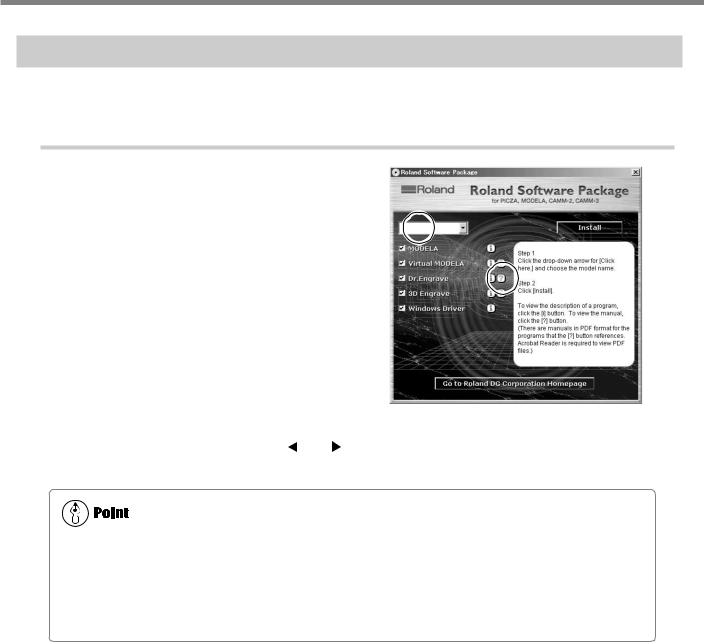
About the Documentation for This Machine
Viewing Manuals in Electronic Format
You can view the manuals in electronic format on a computer running Windows (Windows 95 or later).
Procedures for Viewing Manuals in Electronic Format
1 |
Place the Roland Software Package in the CD- |
|
ROM drive. The menu screen appears auto- |
|
matically. |
2 |
Click the [Click here] message, then choose the |
|
name of the model you're using (EGX-600 or |
|
EGX-400). |
3 |
Click the [?] button. Acrobat Reader starts and |
|
the user's manual is displayed. |
|
When you click the button for the first time, the program |
|
for installing and setting up Acrobat Reader may start. |
|
Follow the on-screen instructions to proceed with instal- |
|
lation and setup. |
4 |
You can use the left and right arrow keys on |
|
the computer keyboard to advance to the next |
page or go back to the previous page.
EGX-600
You can also do the same thing using the [ ] and [ ] buttons on screen.
About Adobe Acrobat Reader
Acrobat Reader is a program required to view files in PDF format. Installing and setting up Acrobat Reader 4.0, found on the included CD-ROM, lets you view the manual easily on any computer. Acrobat Reader 4.0 is available in versions for Windows 95 or later.
* Acrobat Reader is a product of Adobe Systems Incorporated. For detailed information on how to use it, go to the Acrobat Reader menu and select [Help] to view the online help.
About the Documentation for This Machine |
5 |
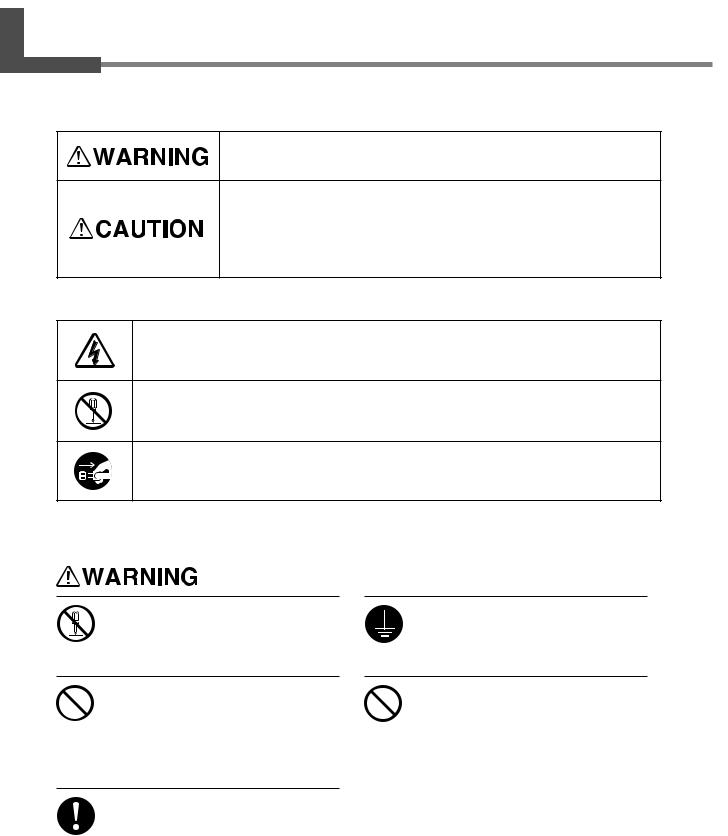
To Ensure Safe Use
About 


 and
and 


 Notices
Notices
Used for instructions intended to alert the user to the risk of death or severe injury should the unit be used improperly.
Used for instructions intended to alert the user to the risk of injury or material damage should the unit be used improperly.
* Material damage refers to damage or other adverse effects caused with respect to the home and all its furnishings, as well to domestic animals or pets.
About the Symbols
The  symbol alerts the user to important instructions or warnings. The specific meaning of the symbol is determined by the design contained within the triangle. The symbol at left means "danger of electrocution."
symbol alerts the user to important instructions or warnings. The specific meaning of the symbol is determined by the design contained within the triangle. The symbol at left means "danger of electrocution."
The  symbol alerts the user to items that must never be carried out (are forbidden). The specific thing that must not be done is indicated by the design contained within the circle. The symbol at left means the unit must never be disassembled.
symbol alerts the user to items that must never be carried out (are forbidden). The specific thing that must not be done is indicated by the design contained within the circle. The symbol at left means the unit must never be disassembled.
The  symbol alerts the user to things that must be carried out. The specific thing that must be done is indicated by the design contained within the circle. The symbol at left means the power-cord plug must be unplugged from the outlet.
symbol alerts the user to things that must be carried out. The specific thing that must be done is indicated by the design contained within the circle. The symbol at left means the power-cord plug must be unplugged from the outlet.
Do not disassemble, repair, or modify.
Doing so may lead to fire or abnormal operation resulting in injury.
Do not use with any electrical power supply that does not meet the ratings displayed on the unit.
Use with any other power supply may lead to fire or electrocution.
Use only with the power cord included with this product.
Use with other than the included power cord may lead to fire or electrocution.
Ground the unit with the ground wire.
Failure to do so may result in risk of electrocution in the event of a mechanical problem.
Do not use while in an abnormal state (i.e., emitting smoke, burning odor, unusual noise, or the like).
Doing so may result in fire or electrocution. Immediately switch off the power, unplug the power cord from the electrical outlet, and contact your authorized Roland DG Corp. dealer or service center.
6 |
To Ensure Safe Use |
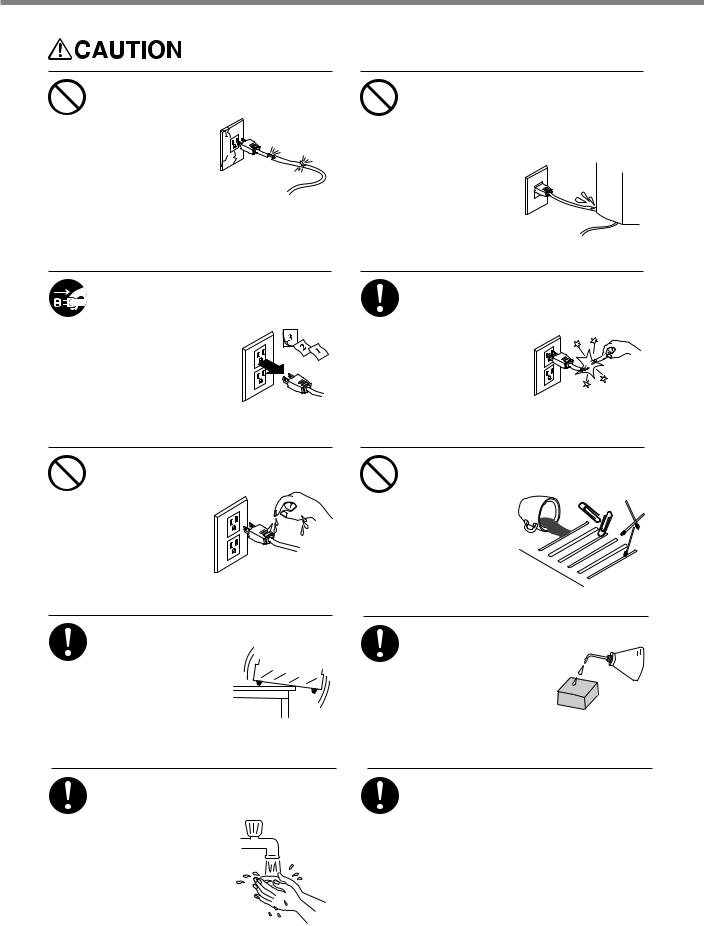
To Ensure Safe Use
Do not use with a damaged power cord or plug, or with a loose electrical outlet.
Doing so may lead to fire, electrical shock, or electrocution.
When not in use for extended periods, unplug the power-cord plug from the electrical outlet.
Failure to do so may result in danger of electrical shock, electrocution, or fire due to deterioration of electrical insulation.
Do not attempt to unplug the powercord plug with wet hands.
Doing so may result in electrical shock or electrocution.
Install on a stable surface.
Failure to do so may result in the unit tipping over, leading to injury.
When you're finished, wash your hands to rinse away all cuttings.
Do not damage or modify the electrical power cord, subject it to excessive bending, twisting, pulling, binding, or pinching, or place any object or weight on it.
Doing so may damage the electrical power cord, leading to fire, electrical shock, or electrocution.
When unplugging the electrical power cord from the power outlet, grasp the plug, not the cord.
Unplugging by pulling the cord may damage it, leading to fire, electrical shock, or electrocution.
Do not allow liquids, metal objects or flammables inside the machine.
Such materials can cause fire.
Perform dry cutting with no cutting oil.
Such materials can cause fire.
Please use a vacuum cleaner to remove cutting dust.
Do not use any blower like airbrush.
Otherwise, dust spread in the air may harm your health.
To Ensure Safe Use |
7 |
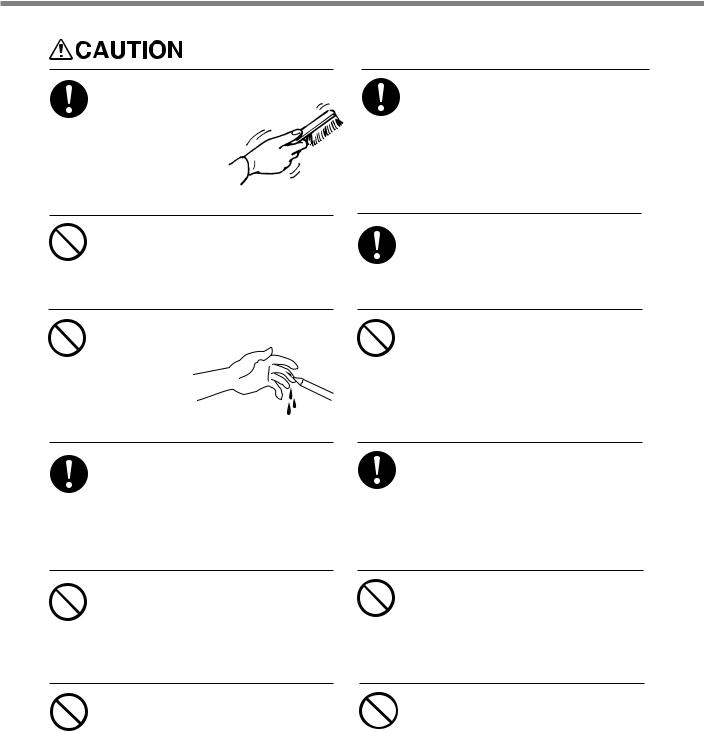
To Ensure Safe Use
Use a commercially available brush to remove metal cuttings.
Attempting to use a vacuum cleaner to take up metal cuttings may cause fire in the vacuum cleaner.
Do not carelessly insert the hands while in operation.
Doing so may result in injury.
Do not touch the tip of the blade with your fingers.
Doing so may result in injury.
Wear dust goggles and mask during use.
Cutting dust may scatter, causing bodily injury.
Do not wear gloves, a necktie or widesleeved clothing.
They may become caught in the tool, resulting in injury.
Do not operate if a spindle cover is cracked or broken.
If the spindle is cracked, contact a service agent immediately for repairs.
Unpacking, installation, and moving are operations that must be carried out by four or more persons.
Failure to do so may result in falling of the unit, leading to injury.
Fasten the spindle, tool, and material securely in place.
Otherwise they may come loose during cutting, resulting in injury.
Do not operate beyond capacity or subject the tool to undue force.
The tool may break or fly off in a random direction. If cutting beyond capacity is mistakenly started, immediately turn off the EMERGENCY STOP switch.
Switch off the machine and unplug the power cord from the electrical outlet before performing cleaning or maintenance.
Failure to do so may result in injury or electrical shock.
Do not touch the tool immediately after cutting operating stops.
The tool may have become hot due to friction heat and may cause burns if touched.
Do not touch the spindle motor immediately after a cutting operation has ended.
Doing so may result in burns.
8 |
To Ensure Safe Use |
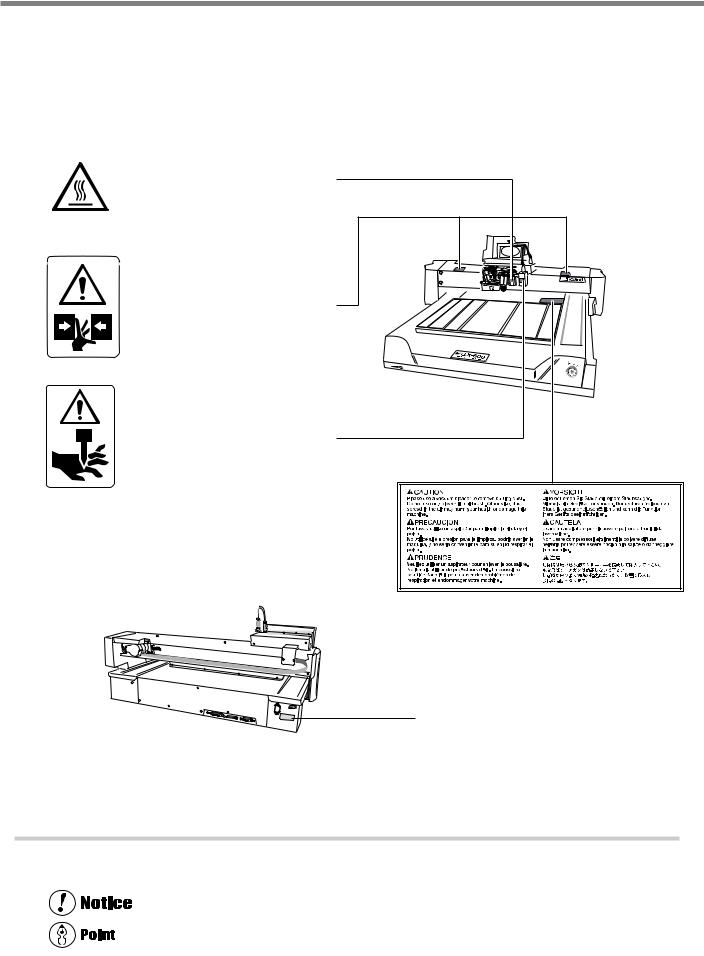
To Ensure Safe Use
About the Labels Affixed to the Unit
These labels are affixed to the body of this product.
The following figure describes the location and content of these messages.
Caution: high temperatures. Do not touch immediately after a cutting operation has ended.
Use care to avoid being pinched. Keep hands away during operation.
Use caution when handling or working with the blade. Careless handling may result in injury.
Model name
Rating plate
Use a rated power supply.
In addition to these symbols, the symbols shown below are also used.
: Indicates information to prevent machine breakdown or malfunction and ensure correct use.
: Indicates a handy tip or advice regarding use.
To Ensure Safe Use |
9 |
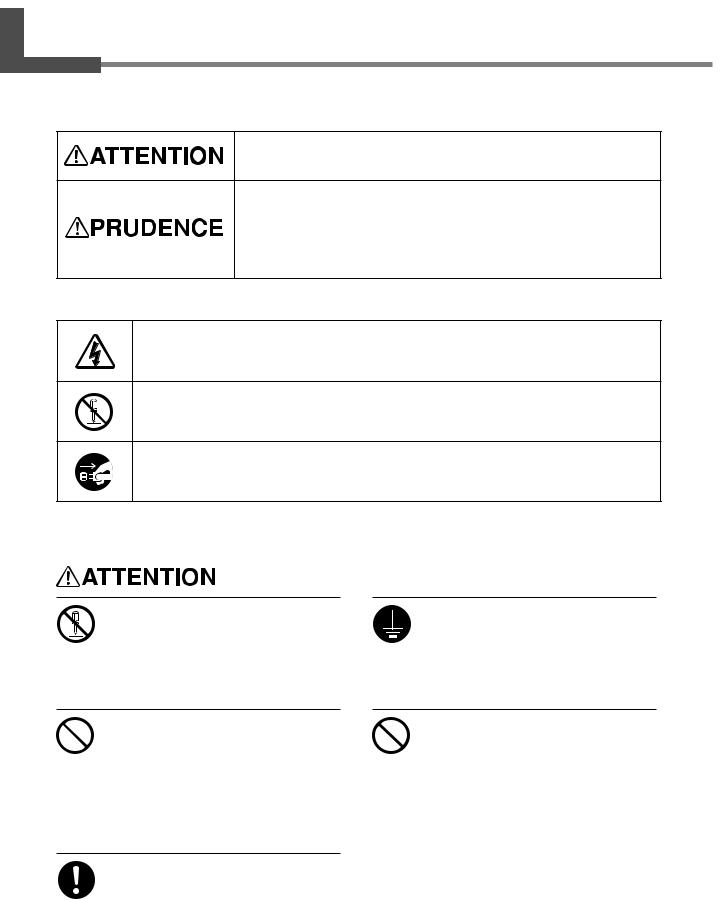
Pour utiliser en toute sé curité
Avis sur les avertissements
Utilisé pour avertir l'utilisateur d'un risque de décès ou de blessure grave en cas de mauvaise utilisation de l'appareil.
Utilisé pour avertir l'utilisateur d'un risque de blessure ou de dommage matériel en cas de mauvaise utilisation de l'appareil.
* Par dommage matériel, il est entendu dommage ou tout autre effet indésirable sur la maison, tous les meubles et même les animaux domestiques.
À propos des symboles
Le symbole  attire l'attention de l'utilisateur sur les instructions importantes ou les avertissements. Le sens précis du symbole est déterminé par le dessin à l'intérieur du triangle. Le symbole à gauche signifie "danger d'électrocution".
attire l'attention de l'utilisateur sur les instructions importantes ou les avertissements. Le sens précis du symbole est déterminé par le dessin à l'intérieur du triangle. Le symbole à gauche signifie "danger d'électrocution".
Le symbole  avertit l'utilisateur de ce qu'il ne doit pas faire, ce qui est interdit. La chose spécifique à ne pas faire est indiquée par le dessin à l'intérieur du cercle. Le symbole à gauche signifie que l'appareil ne doit jamais être démonté.
avertit l'utilisateur de ce qu'il ne doit pas faire, ce qui est interdit. La chose spécifique à ne pas faire est indiquée par le dessin à l'intérieur du cercle. Le symbole à gauche signifie que l'appareil ne doit jamais être démonté.
Le symbole  prévient l'utilisateur sur ce qu'il doit faire. La chose spécifique à faire est indiquée par le dessin à l'intérieur du cercle. Le symbole à gauche signifie que le fil électrique doit être débranché de la prise.
prévient l'utilisateur sur ce qu'il doit faire. La chose spécifique à faire est indiquée par le dessin à l'intérieur du cercle. Le symbole à gauche signifie que le fil électrique doit être débranché de la prise.
Ne pas dé monter, ré parer ni modifier.
Démonter, réparer ou modifier l'appareil risque de provoquer un incendie ou de causer un fonctionnement anormal entraînant des blessures.
Ne pas utiliser avec une source d'alimentation é lectrique non conforme à la norme indiqué e sur l'appareil.
Utiliser l'appareil avec une autre source d'alimentation risque de provoquer un incendie ou de causer une électrocution.
Utiliser l'appareil uniquement avec le fil é lectrique fourni.
Utiliser l'appareil avec un autre fil risque de provoquer un incendie ou une électrocution.
Mettre l'appareilà la terre avec le fil de mise à la terre.
Ne pas respecter cette consigne peut créer un risque d'électrocution en cas de panne mécanique.
Ne pas utiliser l'appareil s'il est dans un é tat anormal (p.ex., é mission de fumé e, odeur de brû lé , bruit inhabituel ou autre anomalie).
Ne pas respecter cette consigne risque de provoquer un incendie ou une électrocution. Couper immédiatement l'alimentation électrique, débrancher le fil de la prise et communiquer avec le revendeur ou le centre de service autorisés de la société Roland DG.
10 |
Pour utiliser en toute sécurité |
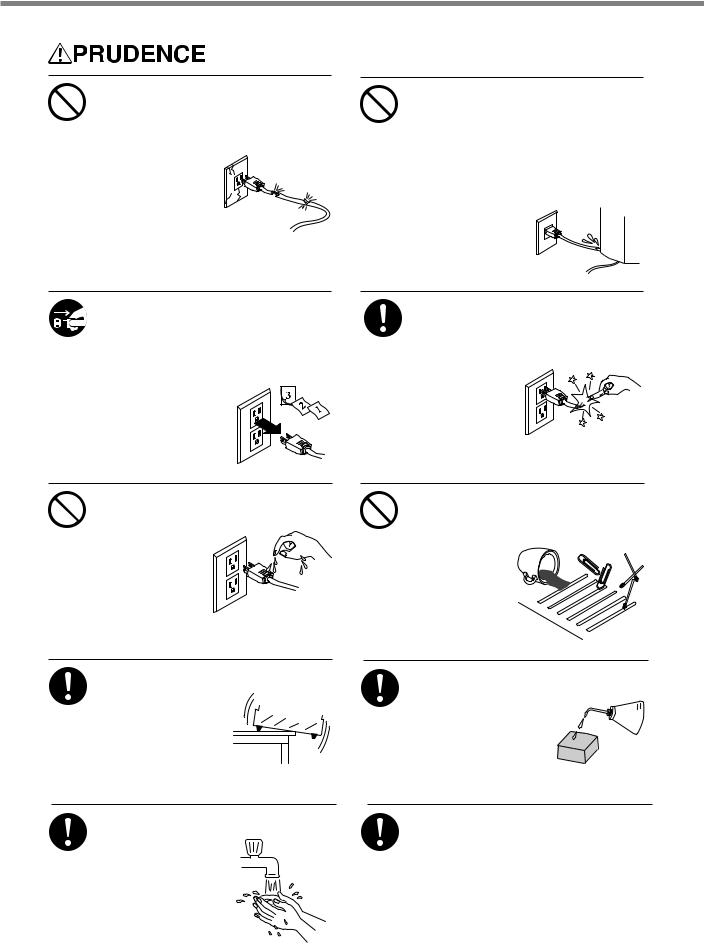
Pour utiliser en toute sécurité
Ne pas utiliser si le fil ou la fiche é lectriques sont endommagé s; ne pas brancher dans une prise mal fixé e.
Négliger de suivre cette consigne risque de provoquer un incendie ou decauser une décharge électrique ou une électrocution.
Si l'appareil reste inutilisé pendant de longues pé riodes, dé brancher la fiche de la prise.
Négliger de suivre cette consigne peut créer un risque de décharge électrique ou d'électrocution ou
provoquer un incendie à cause de la détérioration de
l'isolant électrique.
Ne pas dé brancher le fil avec des mains mouillé es.
Ne pas respecter cette consigne risque de provoquer des décharges électriques ou une électrocution.
Installer sur une surface stable.
Sinon, l'appareil risque de se renverser et de causer des blessures.
Quand vous avez terminé d'utiliser l'appareil, laver vos
mains pour bien enlever tous les copeaux.
Ne pas endommager ni modifier le fil é lectrique. Ne pas le plier, le tordre, l'é tirer, l'attacher ou le serrer de faç on excessive. Ne pas placer d'objet ou de poids sur le fil.
Négliger de suivre cette consigne peut endommager le fil électrique, ce qui risque de provoquer un
incendie ou de causer une décharge électrique ou une électrocution.
Pour dé brancher l'appareil, saisir la fiche et non le fil é lectrique.
Tirer sur le fil peut l'endommager, ce qui risque de provoquer un incendie ou de causer une
décharge électrique ou une électrocution.
Ne pas laisser de liquides ni d'objets mé talliques ou inflammables s'infiltrer dans l'appareil.
De telles infiltrations peuvent provoquer un incendie.
Faire des coupes à sec, sans huile de coupe.
L'huile de coupe peut provoquer un incendie.
Utiliser un aspirateur pour nettoyer les copeaux. N'utiliser aucun appareil soufflant de l'air comme un sè checheveux.
La poussière répandue dans l'air pourrait nuire à votre santé.
Pour utiliser en toute sécurité |
11 |
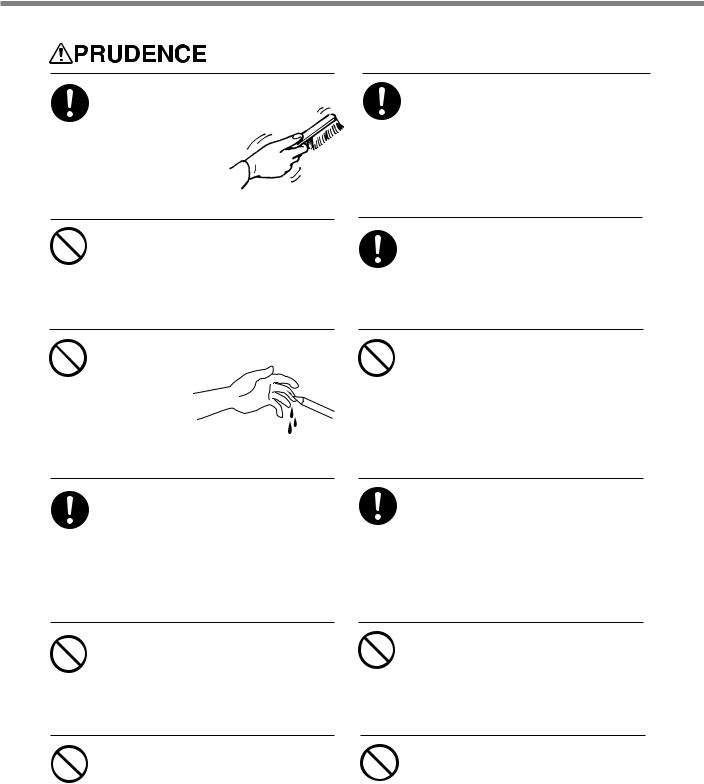
Pour utiliser en toute sécurité
Utiliser une brosse du commerce pour retirer les rognures de mé tal.
Tenter de retirer les rognures de métal à l’aide d’un aspirateur peut faire naître un incendie dans l’aspirateur.
Faire attention de ne pas insé rer ses mains pendant le fonctionnement.
Ne pas respecter cette consigne peut provoquer des blessures.
Ne pas toucher à l’extré mité de la lame avec vos doigts.
Vous risqueriez de vous blesser en y touchant.
Porter des lunettes de travail et un masque durant l'utilisation.
Des copeaux pourraient être projetés et vous blesser.
Ne pas porter de gants, de cravate ou de vê tement à manches amples.
Ils pourraient se prendre dans l'appareil et entraîner des blessures.
N'utilisez pas l'appareil si le couvercle de l'axe est fissuré ou brisé .
Si le couvercle de l'axe est fissuré, communiquez immédiatement avec un agent de service pour faire effectuer les réparations.
Lorsque vous dé placez l'appareil, le saisir par sa base en aluminium et le transporter à 4 personnes ou plus.
Si l'appareil est saisi par la plaque du dessus, il peut tomber et entraîner des blessures.
Fixer fermement le mandrin, l'outil et le maté riel à leur place.
Sinon, ces éléments risquent d'avoir du jeu lors des coupes, ce qui entraînerait des blessures.
Ne pas utiliser l'appareil au-dessus de ses capacité s ou le soumettre à une force excessive.
L'outil pourrait se briser ou être projeté dans une direction indéterminée. Si vous commencez par inadvertance une coupe audessus de la capacité de l'appareil, l'éteindre immédiatement à l'aide du bouton d'urgence.
Couper le contact et dé brancher le câ ble d’alimentation du ré ceptacle avant de procé der au nettoyage ou à l’entretien de l’appareil.
Une négligence à ce niveau pourrait provoquer des blessures ou une électrocution.
Ne pas toucher l'outil immé diatement aprè s une coupe.
L'outil pourrait avoir chauffé avec la friction et vous causer des brûlures.
Ne touchez pas le moteur de l'axe immé diatement aprè s avoir terminé une coupe.
Vous risqueriez alors de vous brûler.
12 |
Pour utiliser en toute sécurité |
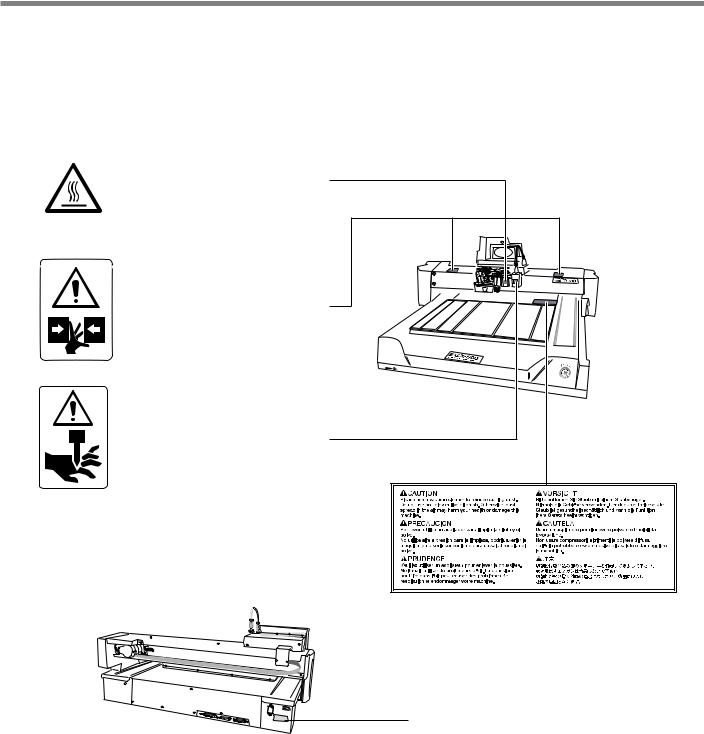
Pour utiliser en toute sécurité
À propos des é tiquettes collé es sur l'appareil
Ces étiquettes sont collées à l'extérieur de l'appareil.
Les dessins suivants indiquent l'endroit et le contenu des messages.
Attention : températures élevées. Ne touchez pas immédiatement après avoir effectué une coupe.
Soyez prudent et évitez les pincements. Éloignez les mains pendant le fonctionnement.
Soyez prudent lorsque vous manipulez ou utilisez la lame, sinon vous risquez de vous blesser.
Nom du modèle
Étiquette des caractéristiques électriques Utiliser l'alimentation appropriée
Pour utiliser en toute sécurité |
13 |
14

1. Getting Started
This chapter describes the procedures extending from unpacking the machine to installing it, and also explains such matters as required terminology and other background knowledge.
15
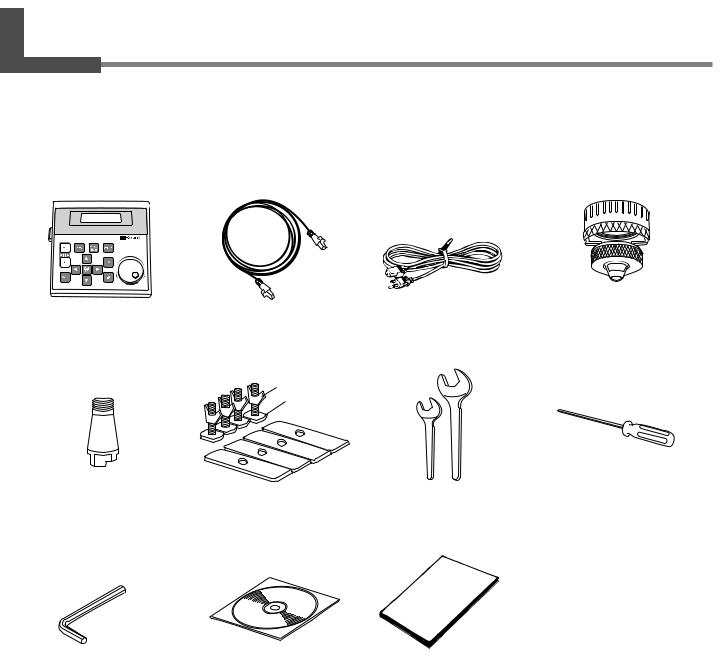
1-1. Included Items and Accessories
Follow the steps in "Unpacking and Repacking" on the packing carton to take out the included items and accessories. Before you attempt installation, make sure all the included items are present.
Operation panel : 1 |
Operation-panel |
Power cord : 1 |
Depth regulator |
|
connector cable : 1 |
|
nose unit : 1 |
|
Nut |
|
|
|
Bolt |
|
|
Solid collet : 1 (*1) |
Clamps : 4 (*2) |
Wrenches |
Hexagonal screw driver |
|
|
(17 mm : 1, 10 mm : 1) |
(2 mm) : 1 |
Hexagonal wrench |
Roland Software Package |
User's Manual |
(3 mm) : 1 |
CD-ROM : 1 |
(this manual) : 1 |
*1 This is for diameter 4.36 mm character cutters and flat cutters. It cannot be used with diamond scrapers or end mills. *2 The bolts and nuts are installed on the machine. (They are used for attaching the packing retainers.)
* This machine does not come with a cutter or cutter holder.
16 |
Chapter 1 - Getting Started |

1-2. Names and Functions
Front
Lock nut
Depth regulator nose unit (Nose unit)
Spindle cover
Pulley
Belt
Spindle motor
Spindle unit
Depth regulator nose unit (Nose unit)
Rail cover |
X-axis rail |
Spindle head
 Arm
Arm
T slot
Bed |
Guide |
Table
Slot cover
Operation-panel
connector Emergency stop switch
Memory-card slot |
Guide securing |
|
|
|
screws |

 Micrometer dial
Micrometer dial
 Nose cone
Nose cone
 Retainer nut
Retainer nut
Chapter 1 - Getting Started |
17 |
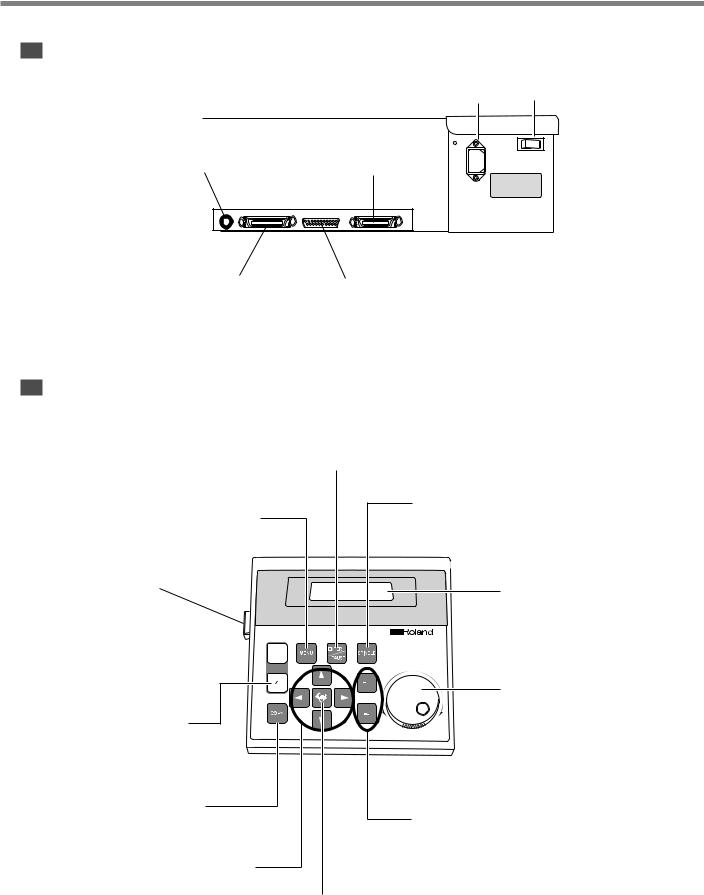
1-2. Names and Functions
Rear
|
Power-cord connector Power switch |
Expansion connector 1 |
Expansion connector 2 |
This connector is for transmitting the |
This is for communication with an |
rotation of the spindle to an external |
external device using the teaching |
device. |
feature. |
Parallel connector |
Serial connector |
This connector is for connection to the printer port on the computer.
This connector is for connection to the COM port on the computer.
Operation Panel
ENTER/PAUSE button
Menu button
This displays the main menu.
Connector
X/Y-axis Origin Set button
This sets the reference point for the 
 cutting position.
cutting position. 


This enables values you enter. Pressing it while cutting is in progress pauses operation.
Spindle button
This starts and stops rotation of the spindle.
Display
Z-axis Origin Set button
This makes settings such as for the reference point for aligning the cutter.
Copy button
This calls up the menu for the copy feature.
Movement buttons
These move the spindle head forward and backward and to the left and right. They are also used for menu operations.
Dial
This adjusts the spindle rotating speed. It is also used for menu operations.
Z-axis Movement buttons
These move the spindle head up and down.
Feed button
This is used in combination with the movement buttons.
18 |
Chapter 1 - Getting Started |
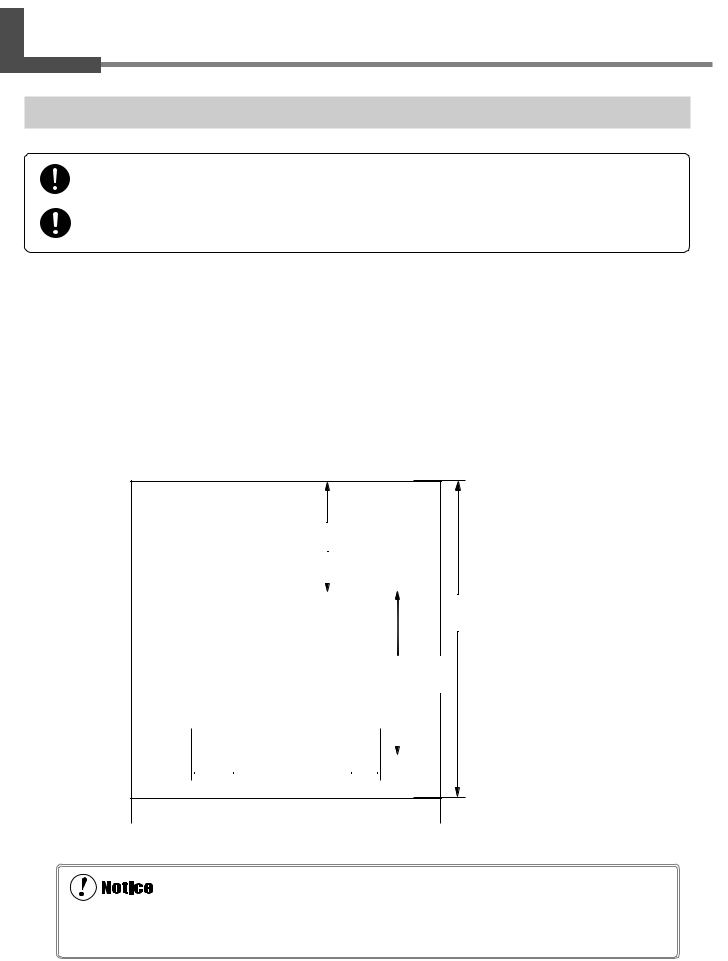
1-3. Installation and Cable Connections
Installation Site and Operating Environment
Install on a stable surface.
Failure to do so may result in the unit tipping over, leading to injury.
Unpacking, installation, and moving are operations that must be carried out by four or more persons.
Failure to do so may result in falling of the unit, leading to injury.
Use this machine in an environment that meets the following conditions.
•Temperature of 5 to 40 ˚C (41 to 104 ˚F) and relative humidity of 35 to 80% (with no condensation).
•A level location with no wobble.
•Little dust.
•Little vibration.
•Good ventilation and heat dissipation.
•Low electrical noise. For example, avoid installing near an electric motor.
Also ensure that the following amount of space is available.
Maintenance space
EGX-600 / EGX-400
900 mm / 900 mm
(35 in./ 35 in.)
Installation space |
|
|
|
|
|
|
|
|
|
|
|
|
|
|
|
|
2600 mm / 2500 mm |
|
|
|
|
|
|
|
|
|
|
|
|
|
|
|
|
|
|
|
|
|
|
|
|
|
|
(103 in./ 100 in.) |
|
(Rear) |
|
|
|
|
|
|
|
|
|
|
|
|
|
|
|
|
|
Main unit |
|
1200 mm / 1000 mm |
|||||
|
|
|
(48 in./ 40 in.) |
|||||
|
|
|
|
|||||
|
(Front) |
|
|
|
|
|
|
|
|
|
|
|
|
|
|
|
|
|
|
|
|
|
|
|
|
|
|
|
|
|
|
|
|
|
|
|
|
|
|
|
|
|
|
|
 1200 mm / 1000 mm
1200 mm / 1000 mm  (48 in./ 40 in.)
(48 in./ 40 in.)
 2100 mm / 1900 mm
2100 mm / 1900 mm  (83 in./ 75 in.)
(83 in./ 75 in.)
When the spindle motor is run at high speed while at a low temperature, rotation may be unstable for some time. In such cases, allow to warm up by running at about 15,000 rpm with no load for around 15 minutes.
Chapter 1 - Getting Started |
19 |
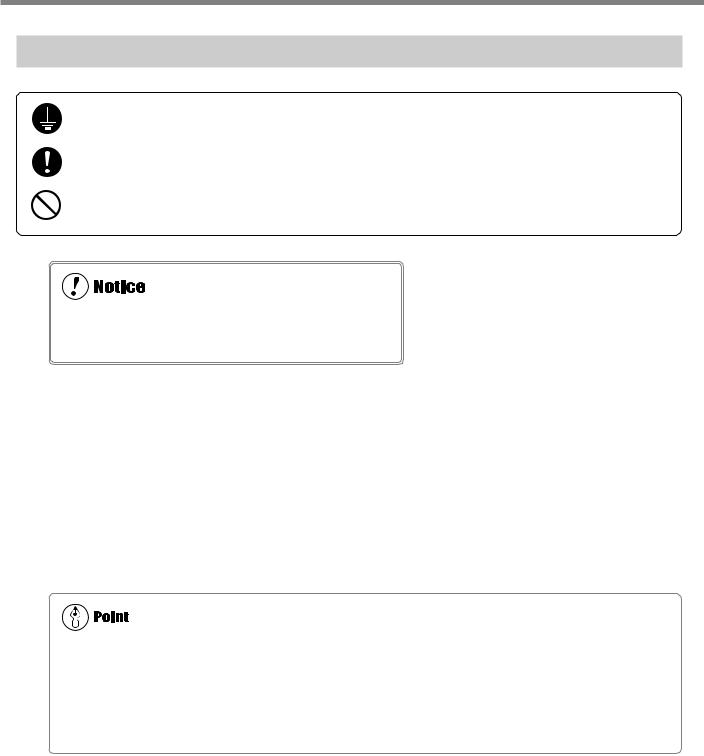
1-3. Installation and Cable Connections
Connecting the Cables
Ground the unit with the ground wire.
Failure to do so may result in risk of electrocution in the event of a mechanical problem.
Use only with the power cord included with this product.
Use with other than the included power cord may lead to fire or electrocution.
Do not use with any electrical power supply that does not meet the ratings displayed on the unit.
Use with any other power supply may lead to fire or electrocution.
Make sure the power to the machine is switched off before attempting to connect or disconnect the cables. Connect securely to ensure that accidental disconnection does not occur during operation.
Connect the operation panel and the power cable. If you're using a computer, then also connect a printer cable or serial cable.
The printer cable or serial cable is sold separately. Use a cable that is compatible with the computer.
Printer cable
Use a commercially available printer cable.
Serial cable
If your computer is an IBM AT-compatible personal computer, then use an optionally available XY-RS-34 cable (or equivalent). A straight cable such as a modem cable will not work.
When the connection uses a serial cable, you need to make sure the communication parameters for the machine match the communication parameters for the computer. For more information about the computer's communication parameters, refer to the documentation for the program. The defaults for the programs included with this machine are set up to match without modification.
Configuring the Communication Parameters for the Machine
See p.109 "I/O Submenus"
20 |
Chapter 1 - Getting Started |
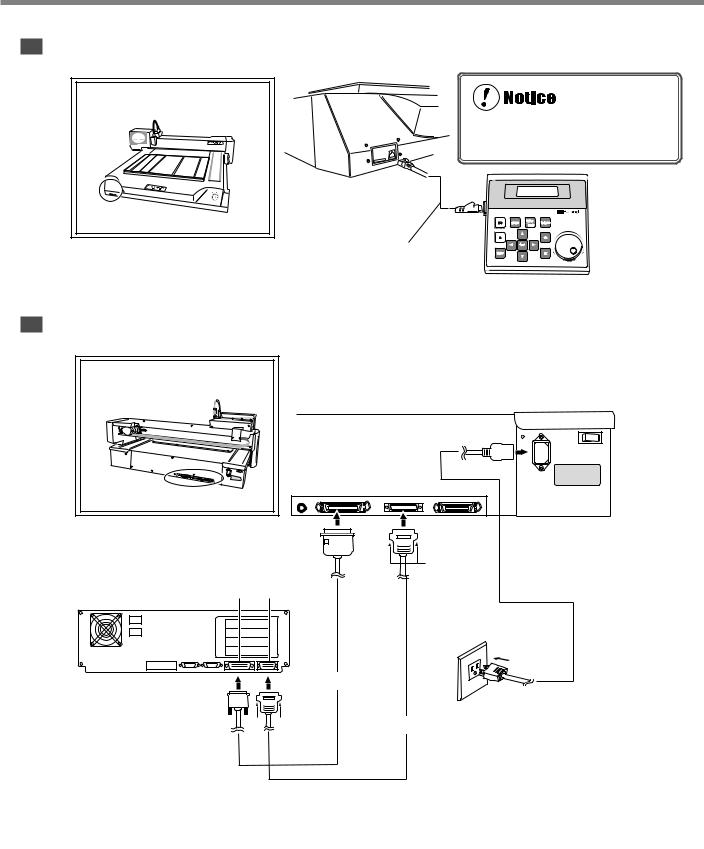
1-3. Installation and Cable Connections
Front
Do not insert an Ethernet cable or connect to a modular jack.
Insert until it clicks into place.
Operation-panel connector cable
Rear
|
Power connector |
Parallel |
Serial |
connector |
connector |
Secure with |
|
the clips. |
Secure with |
|
|
Printer port Serial port |
the screws. |
|
|
|
Power outlet |
Printer cable
Power cord
Serial cable
Connect either a printer cable or serial cable.
Chapter 1 - Getting Started |
21 |
22
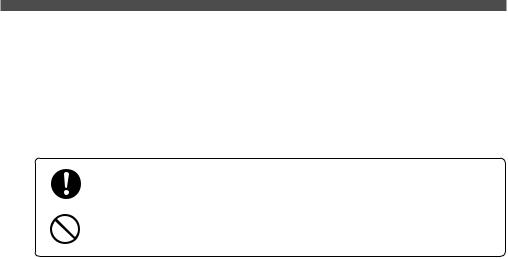
2. Basic Operation
This chapter describes what you should know before you try to use the machine, such as the most basic operations and the procedures for safe use and handling. Be sure to read this chapter before you go on to the next step.
Operating the buttons makes the machine move. When operating the buttons, be sure to keep your hands away from the machine.
Do not let your hair, necktie, or the like touch the machine. There is danger of becoming it caught on the spindle or other moving parts.
23
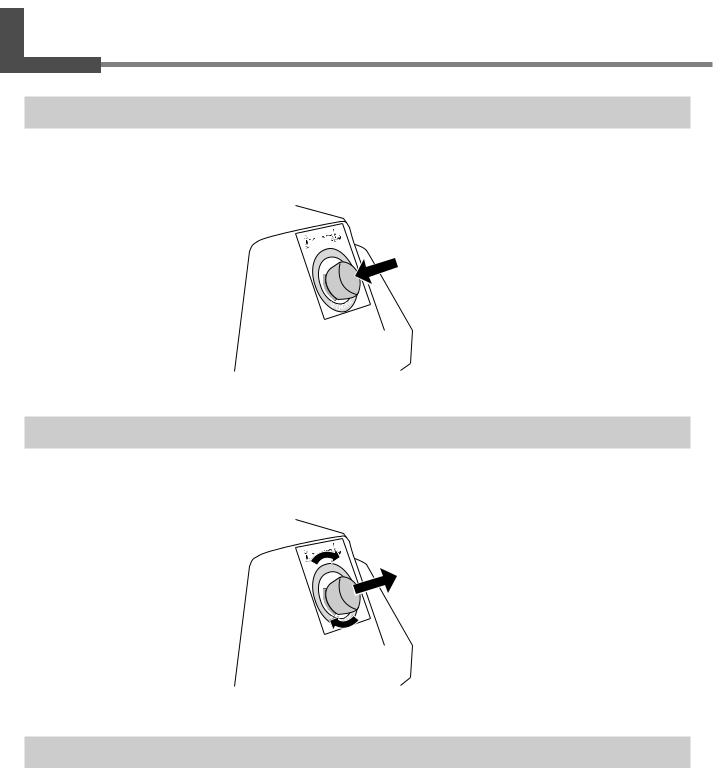
2-1. Emergency Stop to Ensure Safety
How to Perform an Emergency Stop
To stop the machine in an emergency in order to avoid danger, press the emergency stop switch. The machine immediately stops operating and quits cutting. Cutting cannot be resumed.
To Cancel an Emergency Stop
To cancel an emergency stop, turn the emergency stop switch in the direction of the arrow. The machine returns to the state it was in immediately after powerup.
Opening and Closing the Spindle Cover
Be sure to close the spindle cover before you start cutting, and never open it while operation is in progress. For safety, opening the spindle cover during operation causes an emergency stop. To recover, switch off the power to the machine. When the spindle cover is open, only head movement using the movement buttons is possible. You cannot use the buttons to rotate the spindle or perform cutting.
24 |
Chapter 2 - Basic Operation |
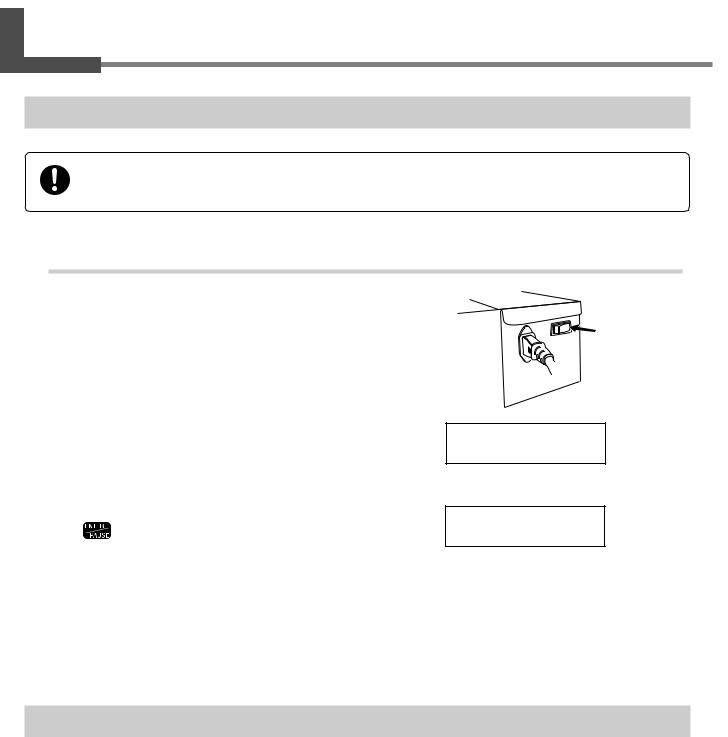
2-2. Switching the Power On and Off
Switching On the Power
Keep your hands away from the machine when you turn on the power. Also, do not place and objects where they may obstruct the operation of the spindle head, X-axis rail, bed, or other components.
Turning On the Power
1 |
Turn on the power switch on the back of the |
|
machine. |
The display shows the model name, and while this is displayed, internal initialization is performed. This takes about ten seconds.
EGX-600
Roland DG Corp.
2 |
When the screen shown at right appears, press |
|
. |
This machine operates at this time. The spindle head moves to the left and back (to the VIEW position), then stops.
3 The display changes to the top screen, and startup ends.
Hit "ENTER" key
X |
0 |
Y 40700 |
Z |
0 |
8000RPM |
|
|
|
Switching Off the Power
Turn off the power switch on the back of the machine. Do not the emergency stop switch for turning the power on and off in day-to-day use.
Chapter 2 - Basic Operation |
25 |
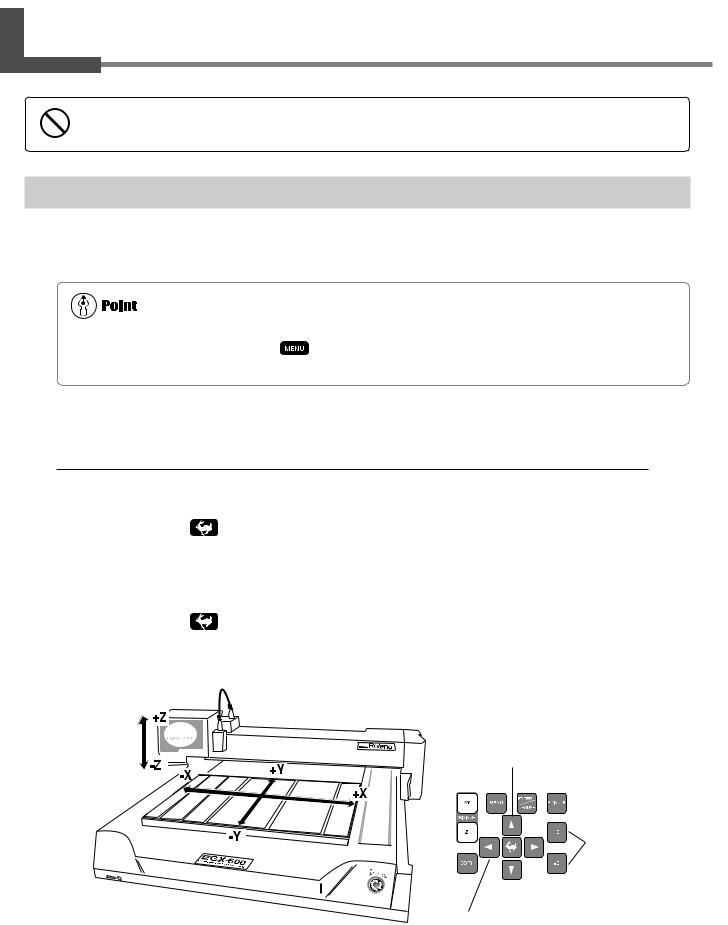
2-3. Moving the Spindle Head
Do not put the operation panel on the machine while operation. Doing so may result in unexpected problems.
Moving the Spindle Head
The spindle head moves in three directions, along the X, Y, and Z axes. When the display shows the top screen, pressing the movement buttons effects movement in the corresponding directions.
Make sure the display shows the top screen. You cannot perform movement |
X |
0 |
Y |
0 |
|
when any other screen is displayed. Press |
several times to display the |
Z |
0 |
|
8000RPM |
top screen. |
|
|
|||
|
|
|
|
|
|
|
|
|
|
|
|
The speed of movement is determined by how you press the movement buttons, as described below.
Pressing and holding down a movement button |
Slow continuous movement |
|
|
|
|
While holding down |
, pressing and holding down |
Fast continuous movement |
a movement button |
|
|
|
|
|
Pressing and releasing a movement button |
Movement of 0.01 mm per press |
|
|
|
|
While holding down |
, pressing and releasing |
Movement of 0.1 mm per press |
a movement button |
|
|
|
|
|
Y-axis direction
Z-axis direction
X-axis direction
26 |
Chapter 2 - Basic Operation |
